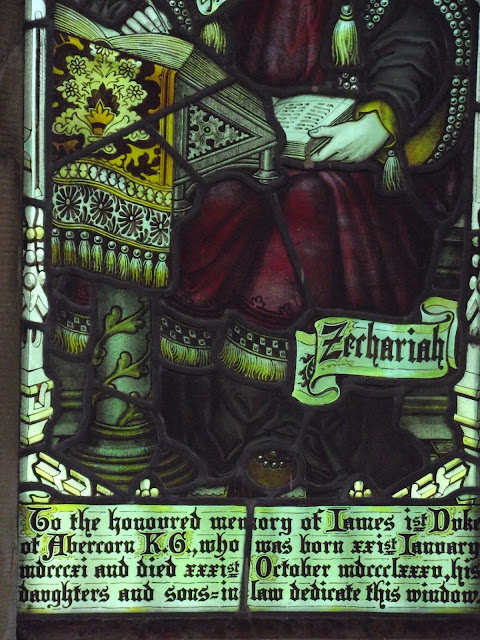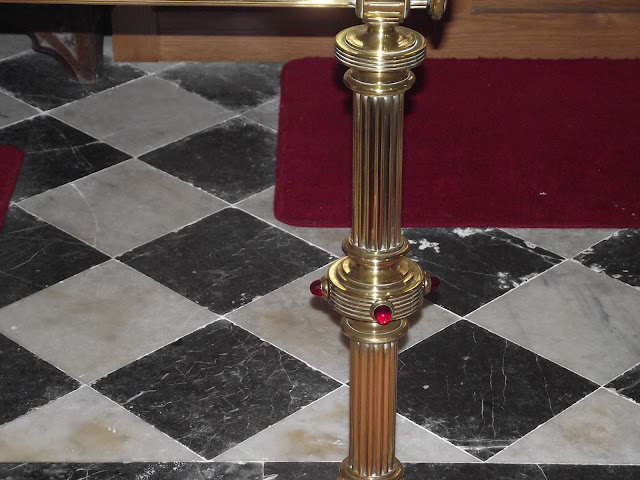Baronscourt was originally a district curacy in the parish of Ardstraw. The parish church, high in the west Tyrone hills six kilometres to the south-west of Newtownstewart, was consecrated on 24th March 1858. It has one of the two lynch gates in the Dioceses of Derry and Raphoe, the other being at All Saints, Newtowncunningham, Co. Donegal. It was erected by the second Duke of Abercorn in memory of his mother. Over the gate are inscribed the words, "I am the resurrection and the life saith the Lord".
The church is more English in style and character. It is entered through a porch in the south wall. The entrance doors commemorate Samuel and Margaret Compton, 1993. The window in the west wall has coloured lattice glass.
There are two windows in the south wall, which have two lights and geometrically patterned lights above, and richly coloured lattice panes.
In the north wall, the first window depicts St. Matthew and St. Mark on the left, and St. John the Baptist and St John the Evangelist on the right.
The second window depicts King David and the Prophet Micah on the left, and the Prophets Isaiah and Zechariah on the right.
They commemorate James, 1st Duke of Abercorn who died in 1885.
In the ceiling there are dormer windows of three lights each and lattice panes.
The east window has three lights and tracery.
The east section depicts faith and commemorates Ronald Douglass Hamilton who died in 1867.
The central section, Charity, is in memory of Beatrix Francis, Countess of Durham who died in 1871.
The right section, Hope, is in memory of Elizabeth, Countess of Edgecombe.
The vestry room is north of the chancel. In the sanctuary, the Ten Commandments are inscribed on each side of the east wall. These, and the tiling of the chancel, commemorate Louisa Jane, Duchess of Abercorn.
The pulpit is on the left and the prayer desk is on the right. The brass eagle lectern was presented by Bishop William Alexander and others in memory of James, 1st Duke of Abercorn, K.G.
The beautifully decorated chamber organ also commemorates Louisa Jane, Duchess of Abercorn. It was built by the Positive Organ Company of London.
There are numerous monuments in the church which commemorate the Hamilton Family, Dukes of Abercorn.
Baronscourt House, surrounded by it's estate and gardens, is amongst the grandest neoclassical houses of its kind in Ireland. It was built between 1779 and 1781 by James Hamilton, eighth Earl of Abercorn. He died in 1789, and was succeeded by his nephew, John James who became the first Marquess of Abercorn in 1790. Following the destruction of Baronscourt by fire in 1796, the house was completely rebuilt. It has been altered a number of times ever since.
The Hamiltons have lived at Baronscourt since before 1566. Their ancestry can be traced far further. For example, an ancestor, James Hamilton was 1st Earl of Arran at the beginning of the 16th century. The first Earl of Abercorn, James Hamilton, was a grandson of the second Earl of Arran. He died in 1617. Another ancestor, James Hamilton (1559-1643), was Viscount Clandeboye. James Hamilton, the sixth Earl of Abercorn (1656-1734), took part in the Siege of Derry in 1689, and was created Viscount Strabane in the Irish Peerage.
James Hamilton, (1811-1885), eldest son of James, Viscount Hamilton, was the first Duke of Abercorn. He succeeded to the title of Marquess of Abercorn in 1818 on the death of his grandfather, the first Marquess.
The above picture shows the grave of James Hamilton, 1st Duke of Abercorn. He was the Lord Lieutenant of Ireland, and as such, he presided over the installation of the Prince of Wales (the future King Edward VII), as a Knight of the Order of St Patrick in 1868. He was raised to the Dukedom as the first Duke of Abercorn on 10th August 1868.
The above picture shows the grave of the 2nd Duke of Abercorn.
The third Duke was the first Governor of Northern Ireland from 1922 to 1945. His Grace, the fifth Duke of Abercorn, the present holder of the title, was made a Knight of the Most Noble Order of the Garter by Her Majesty the Queen in June 1999.
The east section depicts faith and commemorates Ronald Douglass Hamilton who died in 1867.
The central section, Charity, is in memory of Beatrix Francis, Countess of Durham who died in 1871.
The right section, Hope, is in memory of Elizabeth, Countess of Edgecombe.
The vestry room is north of the chancel. In the sanctuary, the Ten Commandments are inscribed on each side of the east wall. These, and the tiling of the chancel, commemorate Louisa Jane, Duchess of Abercorn.
The pulpit is on the left and the prayer desk is on the right. The brass eagle lectern was presented by Bishop William Alexander and others in memory of James, 1st Duke of Abercorn, K.G.
The beautifully decorated chamber organ also commemorates Louisa Jane, Duchess of Abercorn. It was built by the Positive Organ Company of London.
There are numerous monuments in the church which commemorate the Hamilton Family, Dukes of Abercorn.
Baronscourt House, surrounded by it's estate and gardens, is amongst the grandest neoclassical houses of its kind in Ireland. It was built between 1779 and 1781 by James Hamilton, eighth Earl of Abercorn. He died in 1789, and was succeeded by his nephew, John James who became the first Marquess of Abercorn in 1790. Following the destruction of Baronscourt by fire in 1796, the house was completely rebuilt. It has been altered a number of times ever since.
The Hamiltons have lived at Baronscourt since before 1566. Their ancestry can be traced far further. For example, an ancestor, James Hamilton was 1st Earl of Arran at the beginning of the 16th century. The first Earl of Abercorn, James Hamilton, was a grandson of the second Earl of Arran. He died in 1617. Another ancestor, James Hamilton (1559-1643), was Viscount Clandeboye. James Hamilton, the sixth Earl of Abercorn (1656-1734), took part in the Siege of Derry in 1689, and was created Viscount Strabane in the Irish Peerage.
James Hamilton, (1811-1885), eldest son of James, Viscount Hamilton, was the first Duke of Abercorn. He succeeded to the title of Marquess of Abercorn in 1818 on the death of his grandfather, the first Marquess.
The above picture shows the grave of James Hamilton, 1st Duke of Abercorn. He was the Lord Lieutenant of Ireland, and as such, he presided over the installation of the Prince of Wales (the future King Edward VII), as a Knight of the Order of St Patrick in 1868. He was raised to the Dukedom as the first Duke of Abercorn on 10th August 1868.
The above picture shows the grave of the 2nd Duke of Abercorn.
The third Duke was the first Governor of Northern Ireland from 1922 to 1945. His Grace, the fifth Duke of Abercorn, the present holder of the title, was made a Knight of the Most Noble Order of the Garter by Her Majesty the Queen in June 1999.
Two points of extreme curiosity that one should make a note of when visiting Baronscourt Church.
1. Ruby Studded Communion Rails.
2.
The grave of a member of the Hamilton Clan. The date is somewhat peculiar.
Acknowledgement:
The Earl-Bishop is indebted to the Rector of Baronscourt Parish Church, The Rev. Ivan Dinsmore.






































Excellent article and photos. Wasn't aware of this lovely church.
ReplyDeleteTim
CivilRecords.IrishGenealogy.ie
ReplyDeleteDEATHS
Superintendent Registrar’s District: Strabane
Registrar’s District: Newtownstewart
Deaths Registered in the District of: Newtownstewart
Union of: Strabane
County: Tyrone
Name: JAMES HAMILTON
Date of Death: 23 June 1914
Death Place: Cloonty
Condition: Married
Age: 69 (1845)
Occupation: Labourer
Cause: Carcinoma of Rectum, Certified
Informant: J. HAMILTON, Son, present at death, Cloonty
Registration Date: 29 June 1914
CivilRecords.IrishGenealogy.ie
DEATHS
Superintendent Registrar’s District: Strabane
Registrar’s District: Newtownstewart
Deaths Registered in the District of: Newtownstewart
Union of: Strabane
County: Tyrone
Name: ISABELLA HAMILTON
Date of Death: 5 July 1916
Death Place: Cloonty
Condition: Widow
Age: 70 (1846)
Occupation: Widow of Labourer
Cause: Cerebral Thrombosis, Certified
Informant: JOSEPH HAMILTON, Son, present at death, Cloonty
Registration Date: 10 July 1916
A very interesting and informative article on this absolutely beautiful church. May I just point out one small error. In the second paragraph, it makes reference to the entrance doors in the south wall commemorating Samuel and Margaret Compton. Their surname should actually read Crompton. An unfortunate mistake. They were my grandparents and are buried in the adjoining graveyard.
ReplyDelete